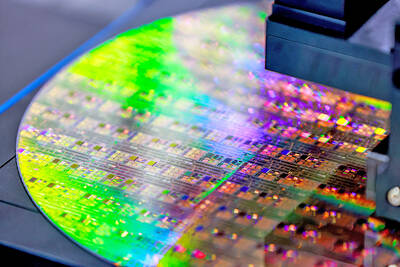DBS Bank Ltd (星展銀行) expects Taiwan’s central bank to raise benchmark rates by 12.5 basis points every quarter through the remainder of this year and next year, lifting the benchmark discount rate by 87.5 basis points to 2.25 percent at the end of next year, DBS economist Ma Tieying (馬鐵英) said in a report.
“That would be within the estimated range of 2 to 3 percent Taylor rule-implied neutral rate,” Ma said in the report issued on March 25.
The Taylor rule, John Taylor’s econometric model that relates actual inflation, desired inflation, real GDP and target GDP, suggests that the US Federal Reserve raises rates when inflation or GDP growth is higher than desired. The rule is often used to predict how a central bank might adjust interest rates.

Photo: Ritchie B. Tong, EPA-EFE
Rate hikes in Taiwan this year and next year should only have a limited impact on household debt, Ma said.
The central bank has introduced four rounds of credit tightening for mortgages to cool the property market and curb household debt growth.
It did not impose further tightening measures last month, which Ma said indicated the bank’s intention to avoid inducing severe pressure on mortgage borrowers.
As liquidity conditions in the banking system remain favorable and local lenders reported a record-low loan-to-deposit ratio of 74 percent, banks might still have the motivation to offer preferential lending rates to expand their loan books given intense competition in the sector, she said.
“Therefore, actual interest costs for mortgage borrowers might not rise sharply in the near term,” Ma said.
DBS in its report revised upward its forecast for Taiwan’s GDP growth this year to 3.8 percent, from the 2.8 percent it predicted in January, citing stronger-than-expected exports and production.
The latest growth prediction compares with the 4.42 percent growth estimate made by the Directorate-General of Budget, Accounting and Statistics.
“The first quarter, which is traditionally a weak season for the electronics sector, is not weak this year,” Ma said.
However, the spread of the Omicron variant of SARS-CoV-2, as well as oil price increases and the war in Ukraine, pose downside risks for Taiwan’s economy ahead, she said.
The government’s relaxation of border controls, quarantine measures and social distancing rules have led to a modest rebound in local COVID-19 cases to about 100 per day since March 19, Ma said.
If a larger-scale Omicron outbreak were to happen in the coming weeks, the nation’s economic recovery would be interrupted in the second quarter, but the effect should be modest and temporary, as about 48 percent of Taiwanese have received a booster shot, she said.
Without the downside risks, Taiwan’s full-year growth could reach 4.5 percent, she added.

Taiwan’s foreign exchange reserves hit a record high at the end of last month, surpassing the US$600 billion mark for the first time, the central bank said yesterday. Last month, the country’s foreign exchange reserves rose US$5.51 billion from a month earlier to reach US$602.94 billion due to an increase in returns from the central bank’s portfolio management, the movement of other foreign currencies in the portfolio against the US dollar and the bank’s efforts to smooth the volatility of the New Taiwan dollar. Department of Foreign Exchange Director-General Eugene Tsai (蔡炯民)said a rate cut cycle launched by the US Federal Reserve

The US government on Wednesday sanctioned more than two dozen companies in China, Turkey and the United Arab Emirates, including offshoots of a US chip firm, accusing the businesses of providing illicit support to Iran’s military or proxies. The US Department of Commerce included two subsidiaries of US-based chip distributor Arrow Electronics Inc (艾睿電子) on its so-called entity list published on the federal register for facilitating purchases by Iran’s proxies of US tech. Arrow spokesman John Hourigan said that the subsidiaries have been operating in full compliance with US export control regulations and his company is discussing with the US Bureau of

Businesses across the global semiconductor supply chain are bracing themselves for disruptions from an escalating trade war, after China imposed curbs on rare earth mineral exports and the US responded with additional tariffs and restrictions on software sales to the Asian nation. China’s restrictions, the most targeted move yet to limit supplies of rare earth materials, represent the first major attempt by Beijing to exercise long-arm jurisdiction over foreign companies to target the semiconductor industry, threatening to stall the chips powering the artificial intelligence (AI) boom. They prompted US President Donald Trump on Friday to announce that he would impose an additional

Pegatron Corp (和碩), a key assembler of Apple Inc’s iPhones, on Thursday reported a 12.3 percent year-on-year decline in revenue for last quarter to NT$257.86 billion (US$8.44 billion), but it expects revenue to improve in the second half on traditional holiday demand. The fourth quarter is usually the peak season for its communications products, a company official said on condition of anonymity. As Apple released its new iPhone 17 series early last month, sales in the communications segment rose sequentially last month, the official said. Shipments to Apple have been stable and in line with earlier expectations, they said. Pegatron shipped 2.4 million notebook